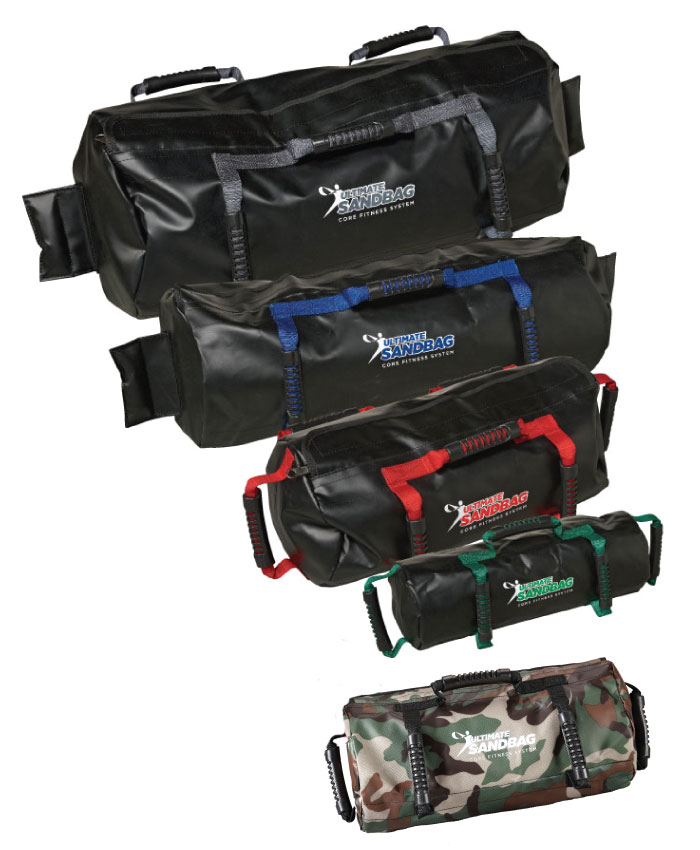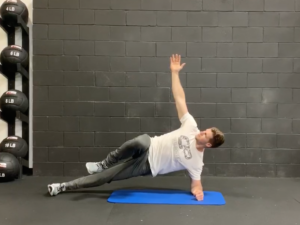
What is Stability Training?
Today’s guest post comes from Josh Henkin. After Dan Swinscoe’s guest post earlier in the week, it seemed like a good follow-up to have Josh speak to the more general principles of stability training.
And, as a friendly reminder, you can get 10% off both sandbag products and educational resources folks at Ultimate Sandbag Training through tomorrow (Sunday) at midnight. Just head HERE and enter the coupon code cressey10.
Enjoy! – EC
Teaching is something that is my passion; it is in my blood, as almost everyone is my family has been a teacher of some sort. Having the wonderful fortune of being able to teach continuing education programs for over a decade, I’ve loved helping professionals find solutions to problems. How do I know what the problems are? Being a coach for 25 years, owning my own gym for a decade, and working with diverse populations has taught me that our true job as a strength coach, fitness professional, or clinician is to be a solution to problems.
Even though we may be looking at solutions to different issues, there tend to be concepts that are key for a wide variety of goals. In order to accomplish our goals in helping people,
we look at the what gives us the “biggest bang for the buck.” Stability training is something that can deliver on that front. In this article, I address stability training methods because they are sorely misunderstood and often lead us to performing exercises we THINK are based around acquiring better stability in a given situation, but we are often missing the goal.
What Is Stability Training?
We could have a LONG dissertation discussing stability training, but I want to focus on some key concepts, how they impact our programming, and the exercises we select. Stability can be something we look at in regard to isolated joints or the whole body. For the sake of this post, we are referencing more of whole body stability.
When you say the words “stability training,” most of us think of exercises that make us wobble or shake a lot. Sadly, that isn’t stability training. In order to address stability, we need a much better understanding of what we are trying to achieve.
Go on the internet and look up stability training or even most textbooks, and you’ll get a wide array of definitions. Probably the best and most simple can be thought of as “allowing wanted movement while resisting unwanted movement.” That seems really simple, but it has been said by some of the best coaches in the industry. If you find that too vague for your liking (don’t overlook simplicity in delivering great concepts), I tend to really like what performance expert, Dr. Brandon Marcello says: “Stability is about timing and sequential activation of muscles.” (1)
Hmm, what is Dr. Marcello referring to in such a statement? Motor control is probably the concept with which many professionals are least familiar. If we look at much of the research on causes of injuries, we tend to see a common theme of a muscle isn’t working at the right time. This flies in the face of the fact that we think if we just make a singular muscle strong it will fix all the problems in movement. Just looking back at all the focus we placed in training the Transverse Abdominis (TVA) is a great example.
While most thought the result of all the studies on the TVA meant we had to isolate and strengthen the TVA, they ignored the points the researchers were making. In a 2017 study by Selkow et. al, they concluded, “TrA activation and timing were altered following a four-week core stability program in people with and without LBP” (2). See the key word of timing, not strength?
What does this really mean for most creating fitness and strength training programs? Our energy in developing stability should be focused upon foundational movement patterns and how we progress them. Dr. Marcello’s makes the complex digestible by defining stability training around three important concepts…
-Feedforward (this is more reactive)
-Static
-Dynamic
With these three concepts there is also one more caveat: they should be multi-planar. Most people are unaware of these ideas when they are creating their stability drills, especially when it comes to being more multi-planar. While I would love to address these all in detail, I’d rather bring some of these concepts to life with a special emphasis on how we go from building a pattern to making it more multi-planar.
Movement Patterns and Planes of Motion
When I created our Dynamic Variable Resistance Training system (DVRT), it was thinking about how we address training movement and not so focused upon specific exercises or muscles. In order to do so, we have to offer concepts that get us all on the same page and speaking the same language. There are three ideas we need to better understand so we can have our training come to life!
Most roll their eyes when you say “functional training,” but it is an actual method that sadly has been hijacked by clever marketing. Spine expert Dr. Stuart McGill sums it up best, “functional training incorporates the goal of enhancing strength throughout the body segment linkage” (3).
That sounds great, but what is Dr. McGill referring to when he says “linkage?” If you have heard about fascial lines, I believe that is a great way to help us better understand that we have specific chains that coordinate the use of different muscles for ways to help us achieve stability so we can demonstrate strength.
If you aren’t familiar with fascial lines, how can we make these concepts meaningful and provide the “Cliff’s Notes” on these concepts? I like to sum it up with these ideas as the following;
1. Hands/Feet: Half of our bones are in our hands and feet, and that is very significant. The contact we have with our environment usually comes from our hands and feet, so coaching them has a huge impact in making these important connections in the body. Renowned physical therapist, Gray Cook says it best!
“If the feet are sloppy and the grip is off, not only will the person not activate the right muscles, but he or she is not even up taking the right sensory information. Let me say that again. If there are any mobility or stability compromises between the foot and the brain, it’s like standing on two garden hoses wondering where all the water is. The information pathway is broken two ways… up and down.”
How does it apply to our training? When I created the Ultimate Sandbag, it was in an effort to create a tool specifically made to address movement, not create a tool and then try to invent a purpose. Simple concepts make our training so much better and teach our clients how to move better instantly! Pretty cool if we can use load as a teaching tool and to provide feedback, not just stress the system.
Examples: Press Out Squats, Arc Press, and Bird Dog Drags
2. Lat/Core/Glutes: While the concepts of fascial lines can make for an entire post, I like to introduce complex subjects with easy to grasp ideas. One of the best examples is the connection of our lat/trunk/ and opposing gluteals to create what is known as the Posterior Oblique Sling (POS). We use this system all the time to create stability for the spine as we perform complex locomotive motion. If you look at an anatomy chart, you can see the fibers of the right lat go right into our thoracolumbar fascia, and travel into the opposing gluteals.
This is why before you do a deadlift, you should try to “break the bar.” With this concept, we have an improved understanding how to develop better exercises and re-think maybe familiar ones. Change is never easy, but appreciating the science should help. This is especially true when we think how the glutes help create stability in what is known as “force closure” of the SI joint.
“Force closure is the term used to describe the other forces acting across the joint to create stability. This force is generated by structures with a fibre direction perpendicular to the sacroiliac joint and is adjustable according to the loading situation. Muscles, ligaments and the thoracolumbar facia all contribute to force closure. Force closure is particularly important during activities such as walking when unilateral loading of the legs creates shear forces.
Force closure creates greater friction and therefore increased form closure and what is called “self-bracing” or “self-locking” of the joint. According to Willard et al. force closure reduces the joint’s ‘neutral zone’ thereby facilitating stabilization.”
Examples: Lift/Chop Hip March, Front Loaded Good Mornings, Deadlift Matrix
3. Progressing Planes of Motion: While we know planes of motion are relevant to what we do in any exercise or real life/sporting movement, we don’t have good systems of actually progressing these concepts. The sagittal plane is not a “bad guy;” it is the most stable plane (why so many like lifting in it) and should be our foundation to teach foundational movement patterns. However, where do we go from there?
In DVRT, we move to focusing on moving through the sagittal plane while resisting the frontal and transverse plane. Then, moving into the frontal plane, and eventually the transverse plane. There are many steps in between, but the highest level in our system is moving one segment of the body in one plane of motion while resisting at another segment. This concept can be applied to any of our seven movment patterns (squat, hip hinge, push, pull, lunge, rotate, and gait) in what we call our MAX (multiple axis) drills. The overall point is that we should think about planes of motion as a training variable with the same value and need of progression as load, volume, etc.
Examples: MAX Lunge, MAX Front Loaded Rear Step Good Morning, Front Loaded Rotations
This is probably a lot of information and a very different way for people to think. Even though questioning what we are doing is difficult, I think of the famous Maya Angelou quote, “Do the best you can, until you know better. Then, when you know better, do better.” Our profession is a rather young one, especially in regard to strength and conditioning and fitness. Evolving and growing only allows us to create better solutions for the people that come to us for help. We have to be open to growing if we are going to make the impact we all desire and that is at the heart of all our goals!
Note from EC: Don’t forget about the great discount in place on sandbags and the associated educational resources at Ultimate Sandbag Training through Sunday at midnight. You can get 10% off by heading HERE and enter the coupon code cressey10.
About the Author
Josh Henkin, CSCS has been in the fitness and performance industry for 25 years. He has been highly sought after for his functional training concepts and DVRT system which has seen him teach in over 13 countries worldwide. Josh has also served as a consultant for the U.S. Marines HITT program, U.S. Army Special Forces Recruiting Battalion, as well as numerous Fire & Police Departments as well as Division 1 programs and Rehabilitation Clinics around the country. You can follow him on Instagram at @UltimateSandbag.
References:
1. The Why’s, What’s, How’s and When’s of Stability Training, “Power & Resiliency Summit”, October 19, 2019, Results Fitness, Newhall, CA.
2. Selkow, Noelle M et al. “Transversus abdominis Activatioin And Timing Improves Following Core Stability Training: A Randomized Trial. “International Journal of Sports Physical Therapy. Volume 12, 7 (2017): 1048-1056.
3. McGill, Stuart, Ultimate Back Fitness and Performance. Waterloo, ON: Wabuno Publishers; 2004 ISBN 0-9735018-0-4. 329p., illustrated Can
4. https://www.otpbooks.com/gray-cook-expanding-on-the-joint-by-joint-approach-part-2-of-3/
5. https://www.physio-pedia.com/Sacroiliac_Joint_Force_and_Form_Closure




